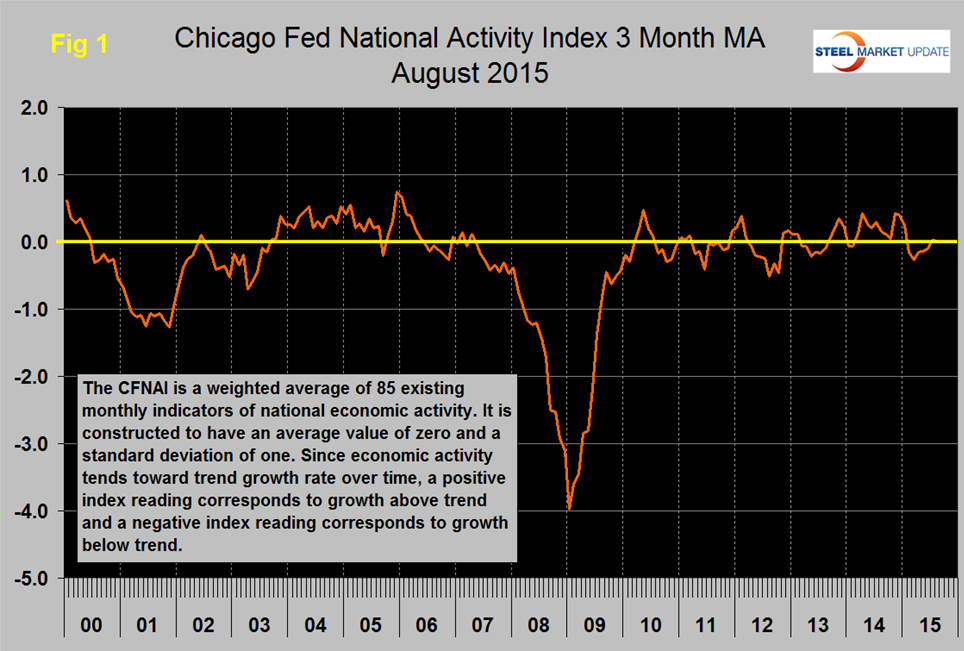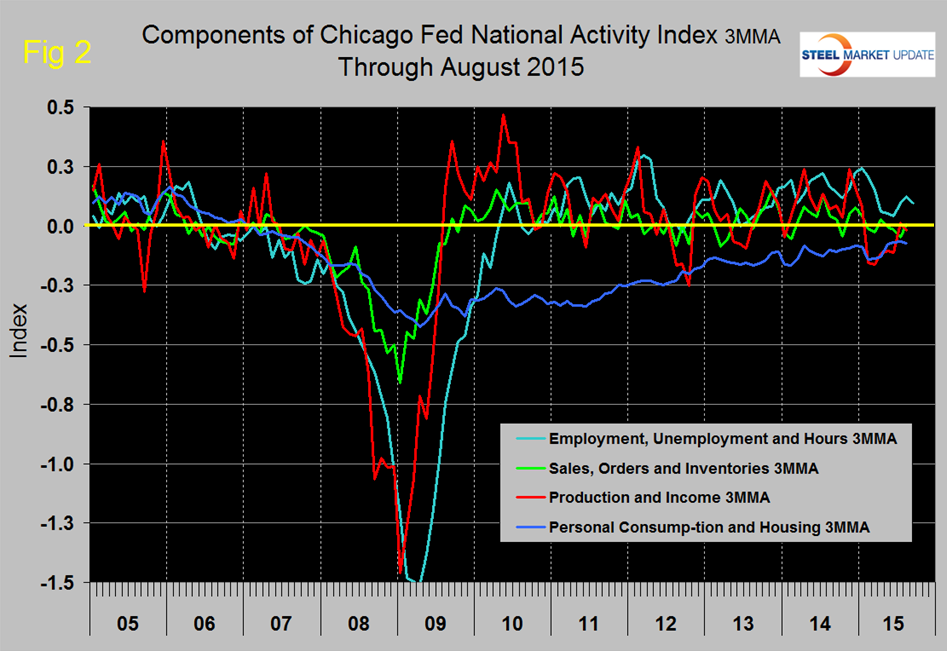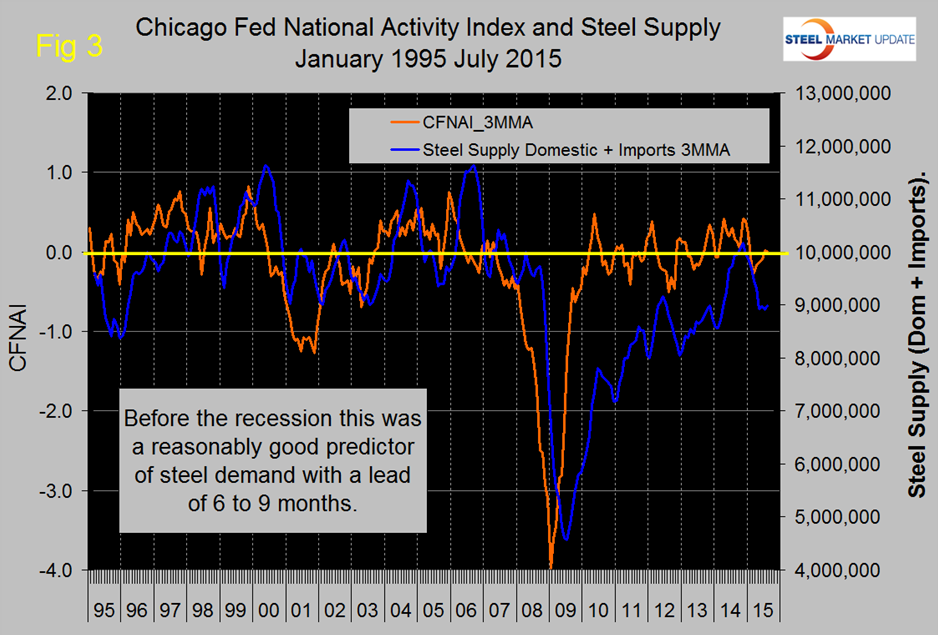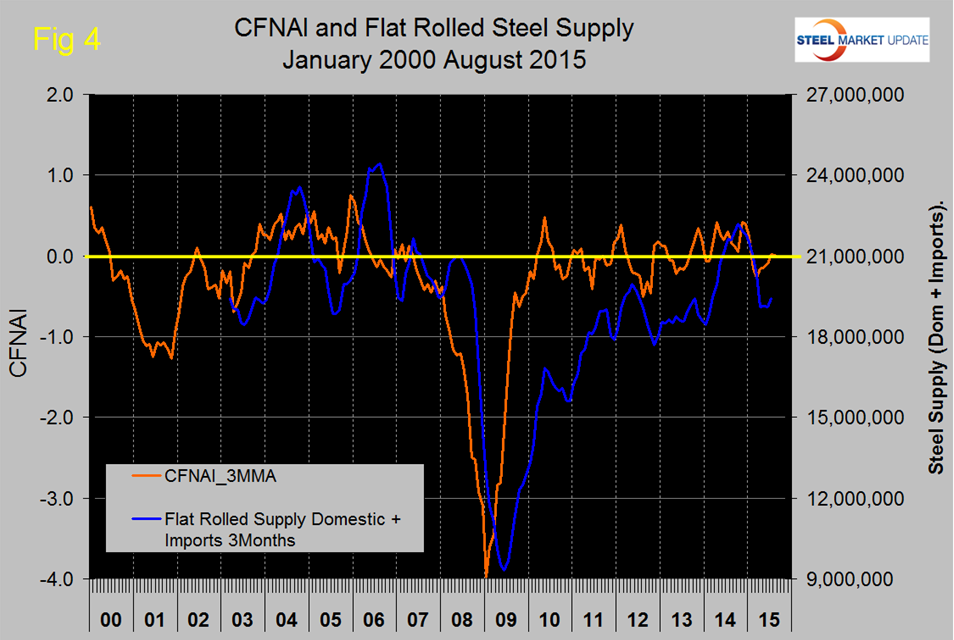Economy

The Chicago Federal Reserve National Activity Index and Steel Supply
Written by Peter Wright
September 25, 2015
The following is the Chicago Federal Reserve statement followed by our own graphical analysis. The CFNAI is an excellent reality check for much of the economic analysis that we routinely provide in The Steel Market Update and is also a reasonably good predictor of steel demand with a six to nine month lead. For example by the time the steel market went off the cliff in September 2008, the CFNAI had been signaling an increasingly severe problem for eight months. Then in the first Q of 2009 the CFNAI was recovering as steel supply was still going south. An explanation of the Index is provided at the end of this piece.
![]() Index shows economic growth slowed in August
Index shows economic growth slowed in August
Led by declines in production-related indicators, the Chicago Fed National Activity Index (CFNAI) fell to –0.41 in August from +0.51 in July. All four broad categories of indicators that make up the index decreased from July, and all four categories made negative contributions to the index in August.
The index’s three-month moving average, CFNAI-MA3, ticked down to +0.01 in August from +0.02 in July. August’s CFNAI-MA3 suggests that growth in national economic activity was very close to its historical trend. The economic growth reflected in this level of the CFNAI-MA3 suggests limited inflationary pressure from economic activity over the coming year.
The CFNAI Diffusion Index, which is also a three-month moving average, decreased to –0.09 in August from +0.05 in July. Twenty-five of the 85 individual indicators made positive contributions to the CFNAI in August, while 60 made negative contributions. Twenty-two indicators improved from July to August, while 62 indicators deteriorated and one was unchanged. Of the indicators that improved, 12 made negative contributions.
The contribution from production-related indicators to the CFNAI fell to –0.30 in August from +0.36 in July. Manufacturing production moved down 0.5 percent in August, following a gain of 0.9 percent in July. Manufacturing capacity utilization declined to 75.8 percent in August from 76.2 percent in the previous month.
Employment-related indicators contributed –0.01 in August to the CFNAI, down from +0.18 in July. Nonfarm payrolls increased by 173,000 in August, following a gain of 245,000 in July; however, the unemployment rate declined to 5.1 percent in August from 5.3 percent in the previous month.
The contribution of the personal consumption and housing category to the CFNAI edged down to –0.08 in August from –0.06 in July. Housing starts moved down to 1,126,000 annualized units in August from 1,161,000 in July. However, housing permits increased to 1,170,000 annualized units in August from 1,130,000 in the previous month. The sales, orders, and inventories category also made a negative contribution to the CFNAI in August, decreasing to –0.03 from +0.03 in July.
The CFNAI was constructed using data available as of September 18, 2015. At that time, August data for 51 of the 85 indicators had been published. For all missing data, estimates were used in constructing the index. The July monthly index was revised to +0.51 from an initial estimate of +0.34. Revisions to the monthly index can be attributed to two main factors: revisions in previously published data and differences between the estimates of previously unavailable data and subsequently published data. The revision to the July monthly index was due primarily to the latter.
Figure 1 shows our analysis of the 3MMA of the CFNAI through August which rose for four straight months through July to reach the neutral threshold, then was almost unchanged in August (see explanation below).
Figure 2 shows the trends of the four main sub-components.
There has been a gradual five year improvement in personal consumption and housing that is ongoing though still below the neutral level. The other three sub-components continue to be erratic, with employment and hours worked currently the strongest. Our observations here seem to be at odds with the official statement because we make no comment at all on the single month’s data and discuss only three month moving averages.
Figure 3 compares the 3MMA of steel supply with the CFNAI and shows that the CFNAI has historically been a reasonably accurate leading indicator of steel demand (apparent supply) with a lead time of six to nine months.
SMU monitors several benchmark indicators to evaluate whether steel consumption is where it should be based on historical patterns, this is one of them. Total steel supply closed the gap in the period mid 2009 through Q4 2014 but in the last eight months has fallen off again probably as a result of the depressed energy sector. Figure 4 and Figure 5 show this same relationship for flat rolled and long products separately, based on a rolling three months tonnage for each.
The difference is quite dramatic and in agreement with our analysis of steel service center shipments. Flat rolled driven mainly by manufacturing came back in line at the end of 2014 but this year has fallen off again. Long products driven mainly by construction is still depressed and since the recession has not come anywhere near where this benchmark predicts. Based on the historical lead of the CFNAI it looks as though total steel demand will pick up in the remainder of 2015 and through Q1 2016.
Explanation: The index is a weighted average of 85 indicators of national economic activity drawn from four broad categories of data: 1) production and income; 2) employment, unemployment, and hours; 3) personal consumption and housing; and 4) sales, orders, and inventories. A zero value for the index indicates that the national economy is expanding at its historical trend rate of growth; negative values indicate below-average growth; and positive values indicate above-average growth. When the CFNAI-MA3 (three month moving average) value moves below –0.70 following a period of economic expansion, there is an increasing likelihood that a recession has begun. Conversely, when the CFNAI-MA3 value moves above –0.70 following a period of economic contraction, there is an increasing likelihood that a recession has ended. When the CFNAI-MA3 value moves above /+0.70 more than two years into an economic expansion, there is an increasing likelihood that a period of sustained increasing inflation has begun.

Peter Wright
Read more from Peter WrightLatest in Economy

New York state manufacturing index drops again in April
Firms were pessimistic, with the future general business conditions index falling to its second lowest reading in the more than 20-year history of the survey

Construction adds 13,000 jobs in March
The construction sector added 13,000 jobs, seasonally adjusted, in March, but tariffs could undermine the industry.

Supply chains, end-users brace for impact from tariffs
Supply chains are working through what the tariffs mean for them

ISM: Manufacturing expansion loses steam after two months of growth
US manufacturing activity slowed in March after two straight months of expansion, according to supply executives contributing to the Institute for Supply Management (ISM)’s latest report.

Chicago Business Barometer rose to 16-month high in March
The Chicago Business Barometer increased for the third-consecutive month in March. Despite this, it still reflects contracting business conditions, as it has since December 2023.





